Borussia Dortmund: How did Eden Terzić take the Westfalenstadion men to the UCL final 2023/24
Without a doubt, Borussia Dortmund are the dark horse of the 2023–24 UEFA Champions League. It’s nearly impossible, the idea of the Westfalenstadion team being in the final, crossed someone’s mind at the beginning of the tournament. However, reality says the opposite: Eden Terzić’s boys will face Real Madrid for the European throne at Wembley Stadium.
The group’s draw put Borussia Dortmund in the death group with Paris Saint-Germain, Rossoneri AC Milan, and the Magpies, who had recently returned to the competition. A group where Eden Terzić’s men were the underdogs on paper. Nevertheless, they qualified in first place, defying the odds, which saw Luis Enrique’s boys in the second spot of the group, sending the seven UEFA Champions League winners to the Europa League and eliminating the St. James Park boys.
Borussia Dortmund played against PSV Eindhoven in the round of 16 and qualified to face Metropolitano team Atlético de Madrid in the quarterfinal. Eden Terzić’s side lost their clash against Diego Simeone’s warriors in the away leg. On their turf, Dortmund players stepped up, turning the result in their favor and kicking the Los Colchoneros out of the league.
In the semi-final, BVB faced Paris Saint-German again, but this time the reward was a spot in the final. Borussia Dortmund proved they are no slouch of a team, going toe to toe against Luis Enrique’s players. So, they put an end to Mbappé’s teammates’ dream of touching the European gold, and consequently, they secured a place in the final.
Buildup Phase – Dortmund
In possession, Borussia Dortmund, like the other top teams, construct their attacks with a 3-2-5 shape with the wingbacks pushed on with the two strikers. Eden Terzić instructed one of his central midfielders to join the attacks to receive the pass between the lines from one of the two defensive midfielders working in close proximity.
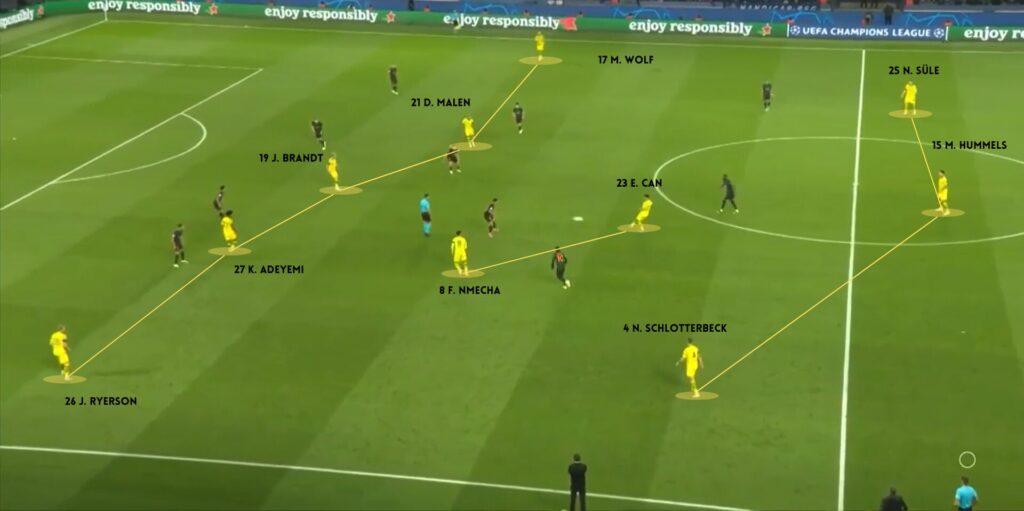
Eden Terzić also used the 4-3-3 formation, building up with a back four with wide-ranging fullbacks. In front of them, he used a single pivot, with Emre Can and box-to-box midfielders taking a position in half spaces to link with the fullbacks in order to bypass the opposition press. The wingers looked to tuck inside, offering more passing options centrally.
The Westfalenstadion team also builds up with a 4+2 shape in which the centre-backs could take different positions. Here, they are close to each other as the right centre-back works in a wide position, allowing the right fullback to step up. The yellow team aimed at overloading the midfield by having one of the central midfielders drop next to the defensive midfielder to provide himself as an outlet. Once Eden Terzić’s boys progressed to the second phase, there was always a free man, usually Julian Brandt, between the lines, shifting to the ball side to overload it, then working a switch to the other side where the opposite fullback could play a cross or cluster the play by combining with the players until the right moment appeared to work the ball into the box.
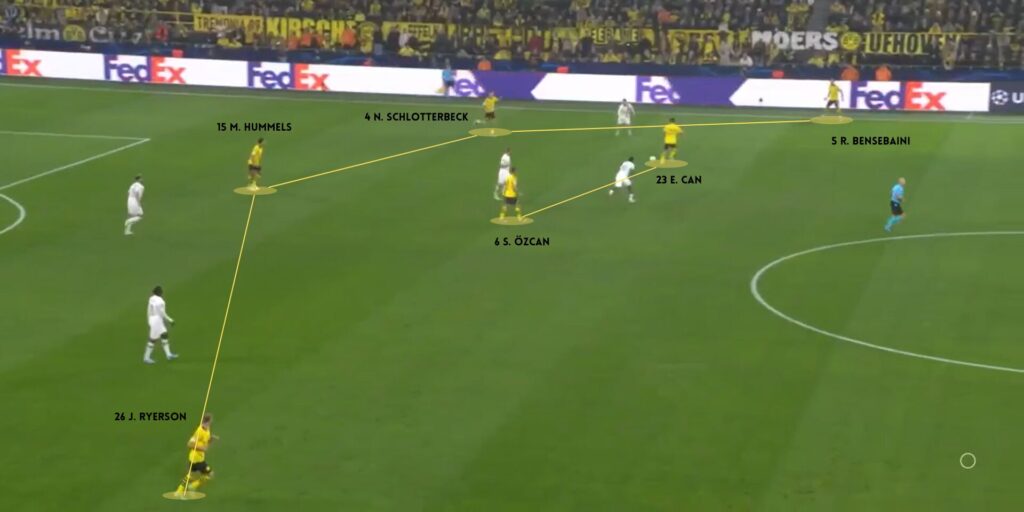
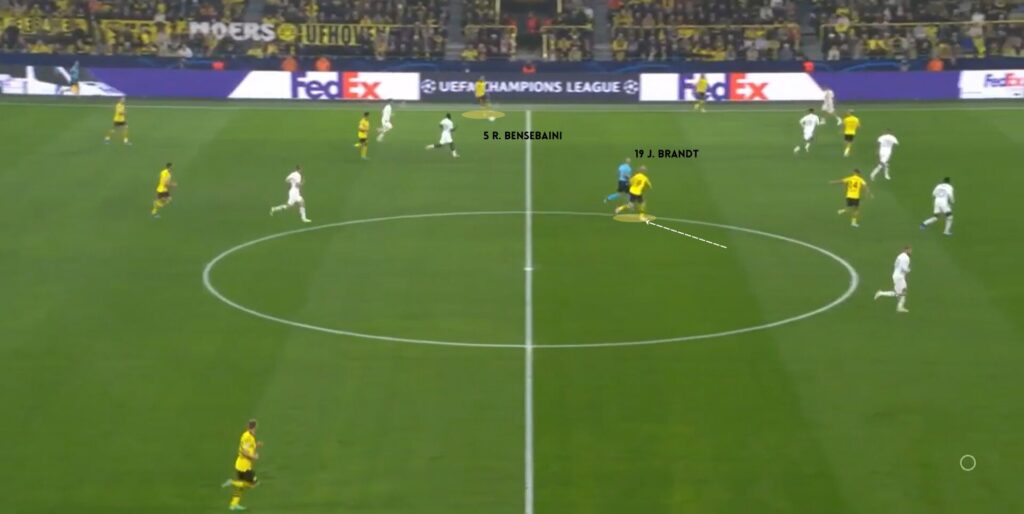
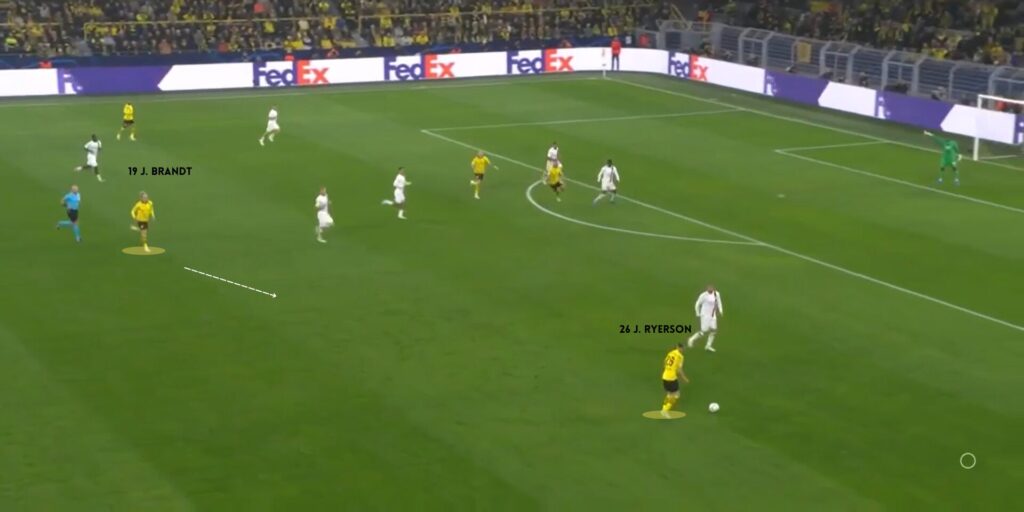
In the late buildup, Borussia Dortmund played with a 3-2-5 shape in which Ramy Bensebaini formed a back three, with Mats Hummels and Nico Schlotterbeck making way for Reyerson to push higher up the pitch. When opponents pressed man-to-man the players involved in the buildup phase, Dortmund relied on progressive passes straight to one of the central players coming deep between the lines. Usually, Julian Brandt was entrusted to fulfill the mission, benefiting from his quality of press resistance while he was carrying the ball forward.
Long balls were also an outlet for Borussia Dortmund, as they targeted Niclas Füllkrug, relying on his ability in hold-up play and capabilities to win aerial duels. Here, Reyerson spots the German striker up top, and he works a long ball toward him.
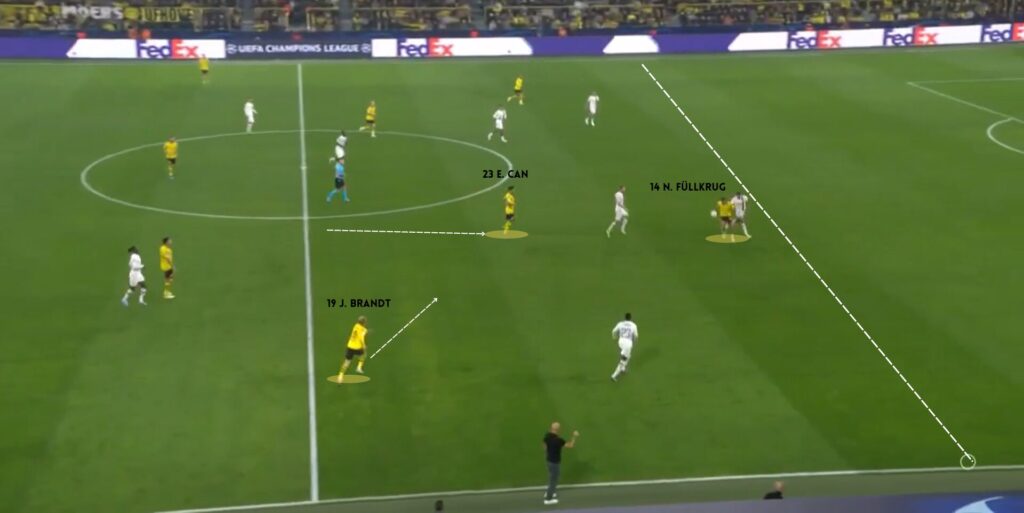
Niclas Füllkrug controls the ball and lays it down to Emre Can. The Dortmund captain decides to go wide, whereas Julian Brandt runs toward the box, insinuating to his captain his readiness to receive the cross.
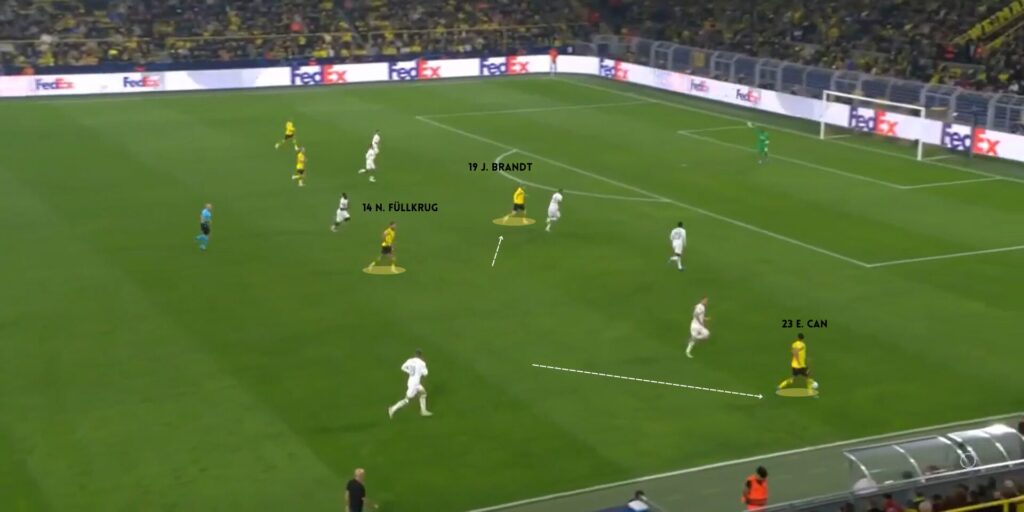
Eden Terzić’s team is incredibly versatile in the construction phase. The 4-2-4 was an option to progress up to the top. Here, Borussia Dortmund’s double pivots are occupied by Musah and Pobega, so the progression through the fullback isn’t a choice. Therefore, Donyell Malen decides to drop deep, dragging Calabria with him to take the progressive pass from Nico Schlotterbeck, which frees up the space for Rami Bensebaini to run and receive the service from the Dutch winger.
In Possession:
Eden Terzić’s boys are great at positional rotations and switches. The fullbacks and the wingers are in constant communication to fill the position of the other once it is vacated, or if someone operates in a wider area, the other has to tuck inside and play on the underlap to make way for the other one to play a cross to the attackers.
Borussia Dortmund are so direct in possession. They set up in a 4-2-4 shape in which Nico Schlotterbeck fires up a progressive pass to the central midfielder, who is instructed to form a front four. The backline players, especially the centre-backs, could always find the free players between the lines. And that’s the advantage of the 4-2-4 formation, as the wingers pin the opposite fullbacks, whereas, the other central players draw the opposite centre-backs attention. In addition, BVB’s fullbacks played on the overlap to create a 2v1 on the flanks.
In settled possession, Eden Terzić lined his team up in a way in which the ball holders always find the free man between the lines. Against Newcastle in St. James Park, the Magpies defended with a 5-4-1 out of possession. Here, the fullbacks hold the width. Mats Hummels, Nico Schlotterbeck, and Emre Can were instructed to take the team into the next phase while the rest was settled between the Newcastle lines. Sabitzer, having the time and space advantage, receives and lays the ball off instantly to Nmecha. During this time, Kieran Trippier and Fabian Schär noticed Jamaal Lascelles being pulled out of his position and leaving space behind him where Marco Reus was attacking. The fear of the latter exploiting the vacated space leads the pair to jump over him, which leaves Niclas Füllkrug unmarked. Dan Burn realises the situation and goes for him, leading to Donyell Malen facing the goalkeeper, but he doesn’t complete the mission successfully. A chain of mistakes was initiated by unmarked players receiving between the lines, and multiple hindsights followed, resulting in a big chance.
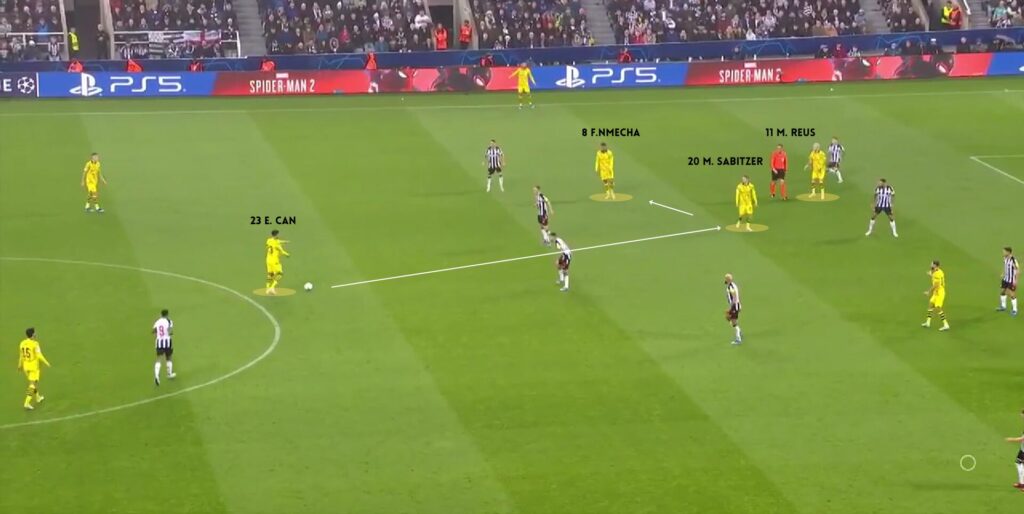
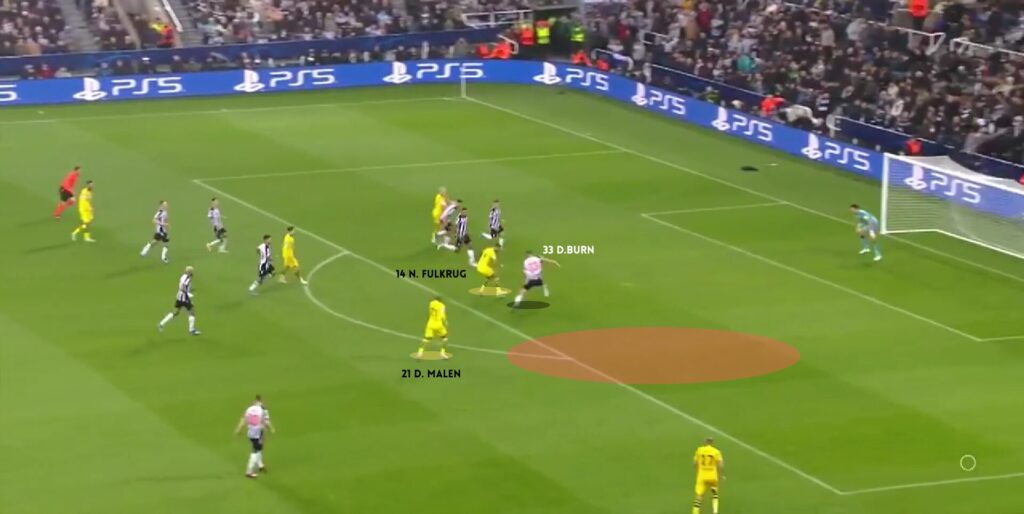
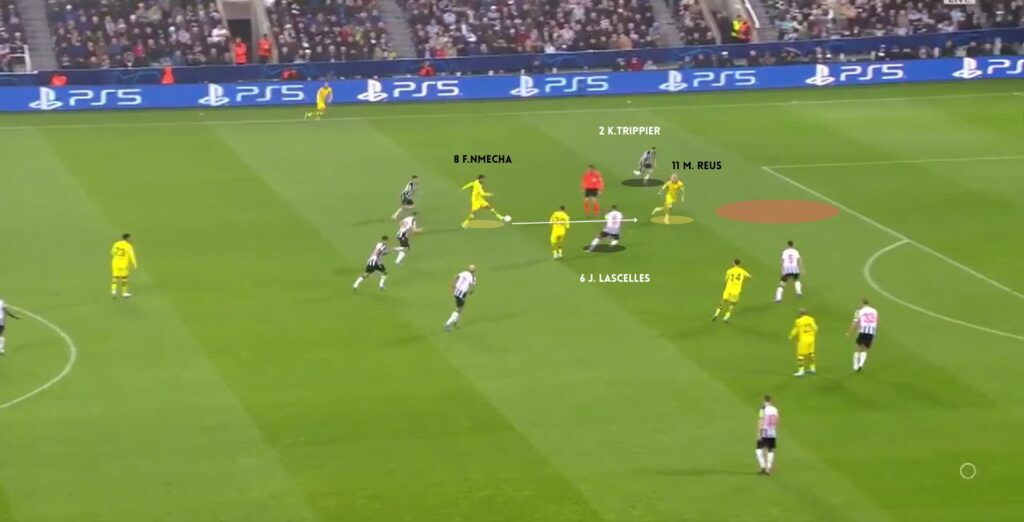
One of the strengths of Borussia Dortmund in the 2023–24 Champions League campaign is their ability to take opponents on as an asset to create chances in the final third. This comes from Karim Adeyemi and Jadon Sancho. The German professional attempted 35 dribbles with a win ratio of 34%, while the Englishman tried 56 take-ons, ranking 5th among the players who participated in this campaign of the UEFA Champions League. The yellow team’s fullbacks are also no slouch of dribblers. Chelsea’s loanee, Ian Maatsen, often plays on the overlap and the underlap as well, timing his runs to combine through one-twos with one of the eights in the half spaces or Niclas Füllkrug taking advantage of him pinning the defenders in the box.
Transitions:
Borussia Dortmund relied on the wide channels to hurt their opponents on the counter, taking advantage of the numerical plus. The yellow team, once they cut the ball off, works direct passes, counting on someone like Niklas Süle playing breaking line balls to Karim Adeyemi or Donyell Malen. Eden Terzić placed them as two strikers up front to exploit spaces using their pace and dribbles. Adding to that, Dortmund always kept themselves ready to surround and counter-press the ball-holder with maximum players and then go for transition.
Proactivity is really what describes the BVB’s centre-backs. Having this quality made them exploit the opposition on the break. With his ability to read the game, Nico Schlotterbeck cuts the ball off, passes it to Marco Reus, and goes for the overlap. By doing so, Borussia Dortmund find themselves in 5v4. The numerical advantage secures a free man (Lukas Nmecha) to receive the cut-back and put the ball in the back of the net.
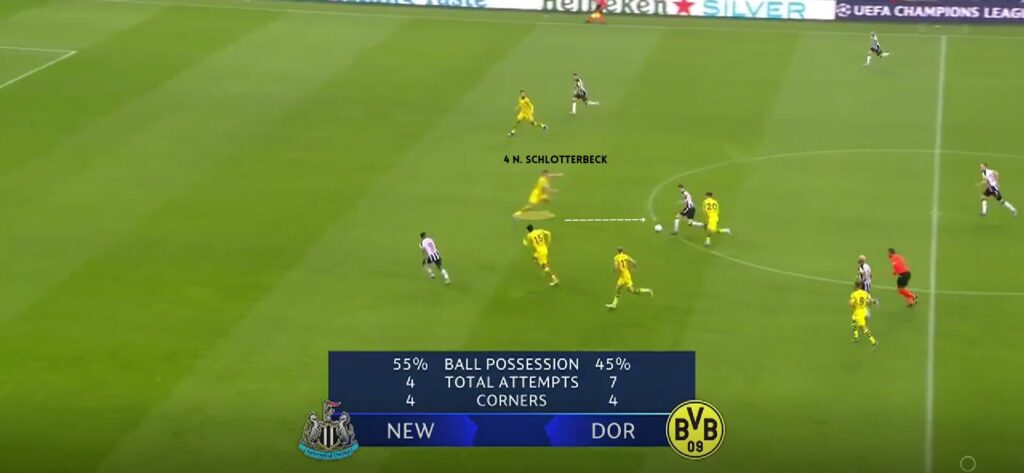
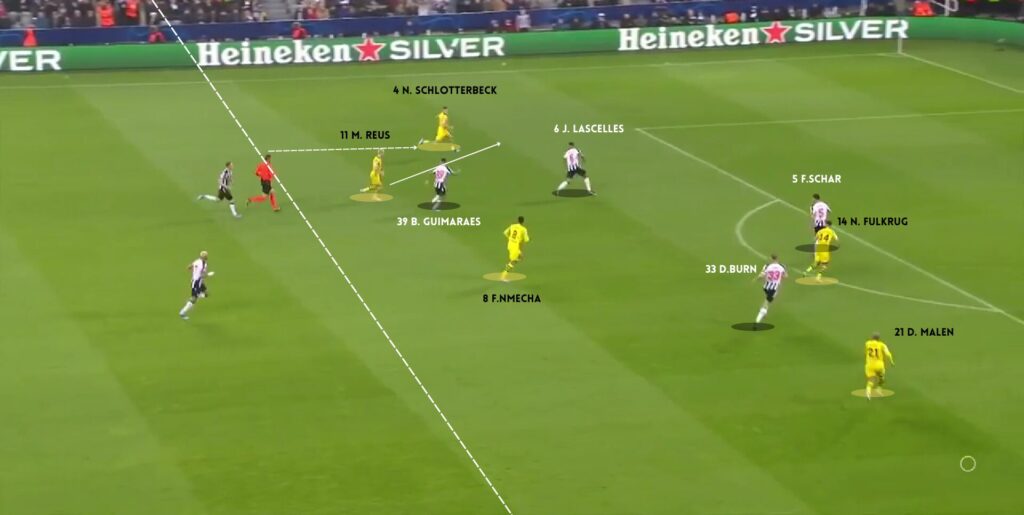
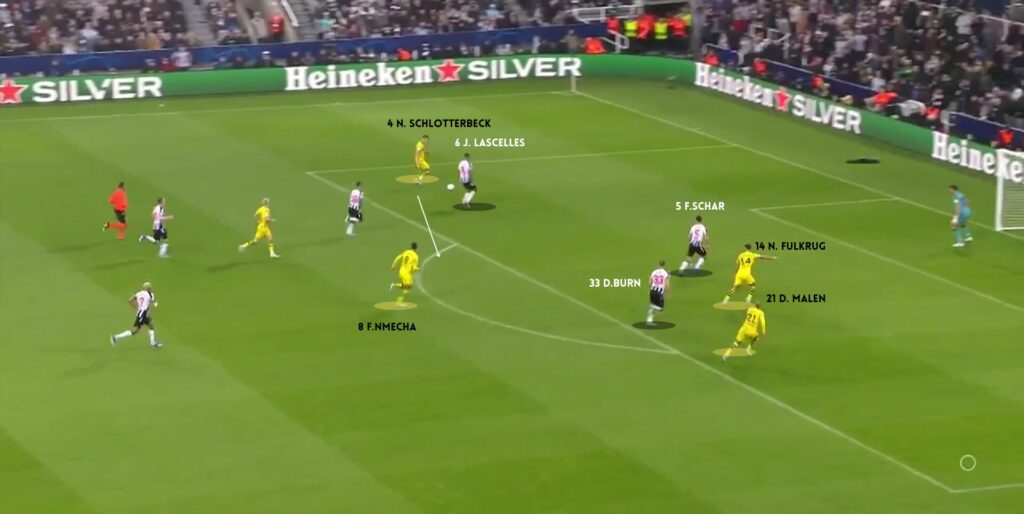
Out of Possession:
Eden Terzić prefers to drive the opposition to the wide channels. Here, Marcel Sabitzer, Emre Can, and Julian Brandt are in the middle of the pitch, overloading Paris Saint-Germain’s central midfielders.
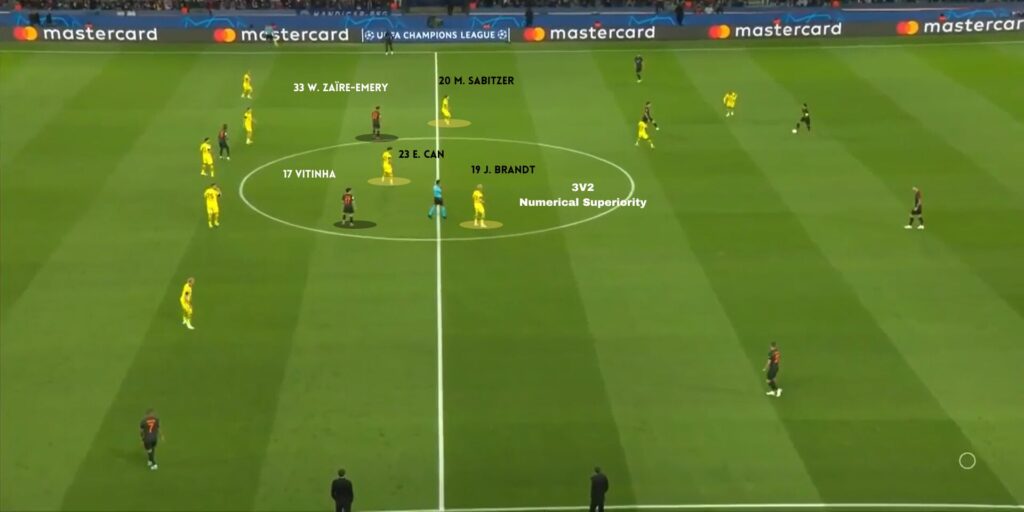
When PSG played near the touchlines, Eden Terzić tried to generate numerical superiority off the ball, ordering his centre-backs and midfielders to shift across, which obligated PSG to go backward and reset the play again.
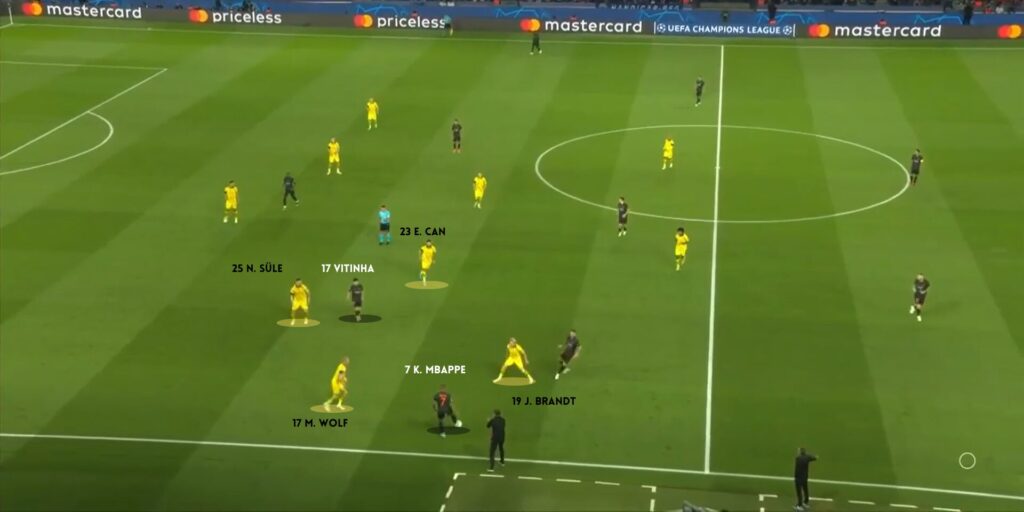
Against teams building up with double pivots, Borussia Dortmund pressed with a 4-3-3 to outnumber the opposition in the midfield. Here, Niclas Füllkrug forces the play to the left side of Paris Saint-German, and Karim Adeyemi runs and presses out to close the passing angle to the fullback. Luis Enrique’s double pivots aren’t a choice to progress through because Marco Reus and Julian Brandt are timing their runs to pounce and steal the ball in a crucial attacking position.
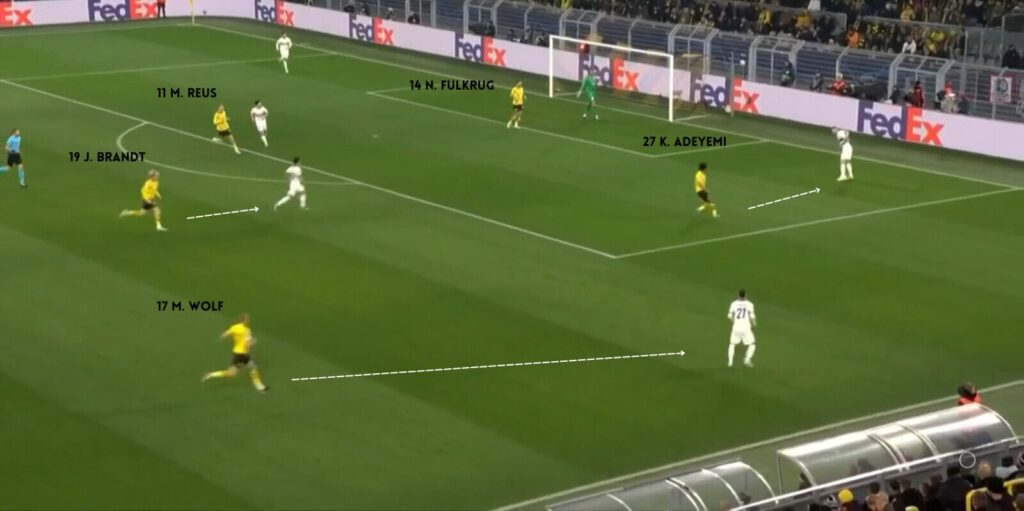
In mid-block, BVB swings between 5-3-2 and 4-4-2 shapes to prevent the central progression from forcing the opposition to go backward or to force them to play in trapped areas. Borussia Dortmund’s double pivots and front two always created a numerical superiority in the middle of the park, trying to outnumber the opponents.
The Westfalenstadion deserved their qualification to the final based on their performances in the group of death and the knockout stages, with a clear playing style based on fluid attacking, killer transitions, defensive prowess, and solidity. Eden Terzić proved his tactical astuteness by being flexible depending on the opponents. The BVB coach climbed the ladder, starting in a part-analyst role, until he became Borussia Dortmund manager and took his team to the pinnacle: the UEFA Champions League final.


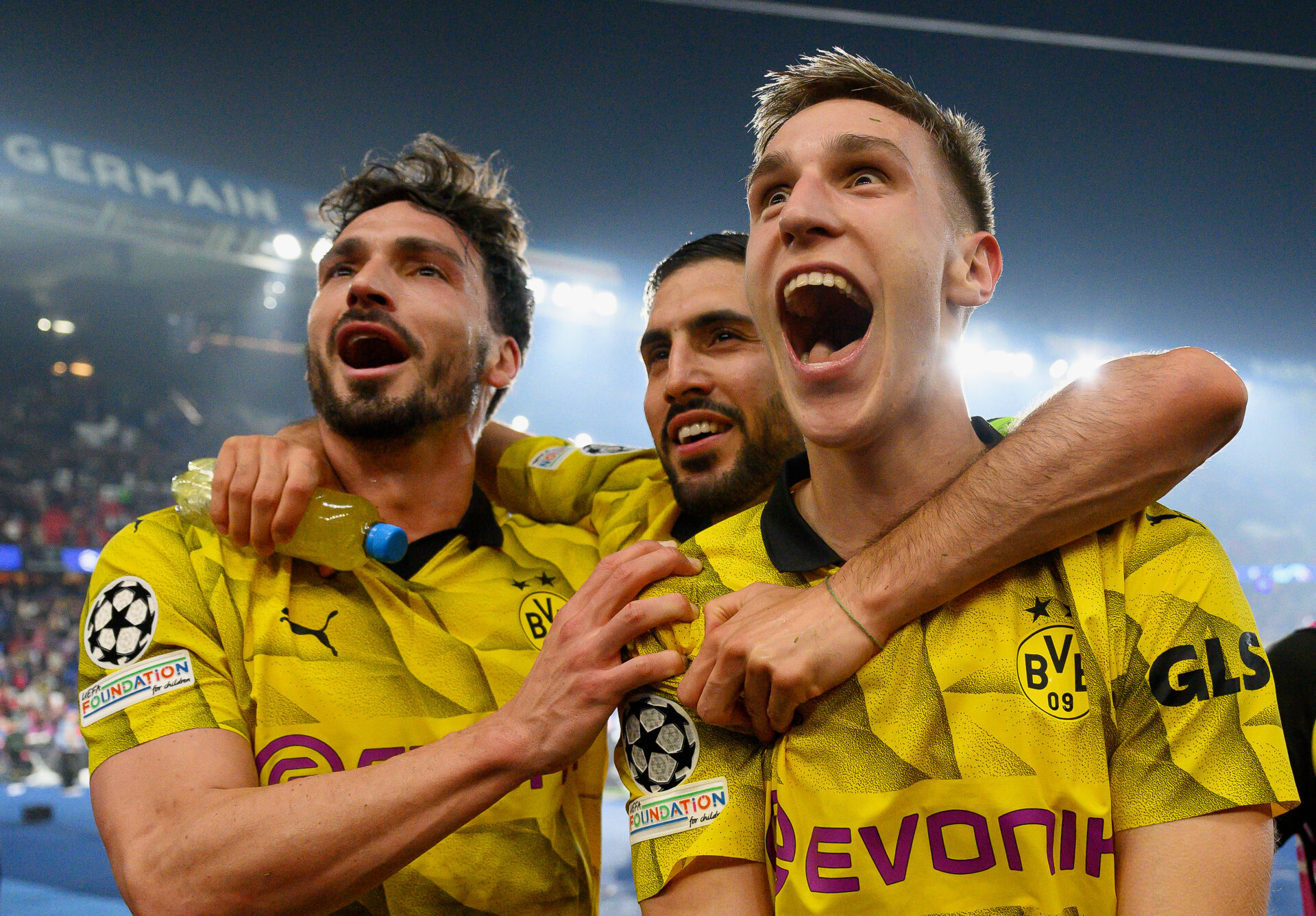

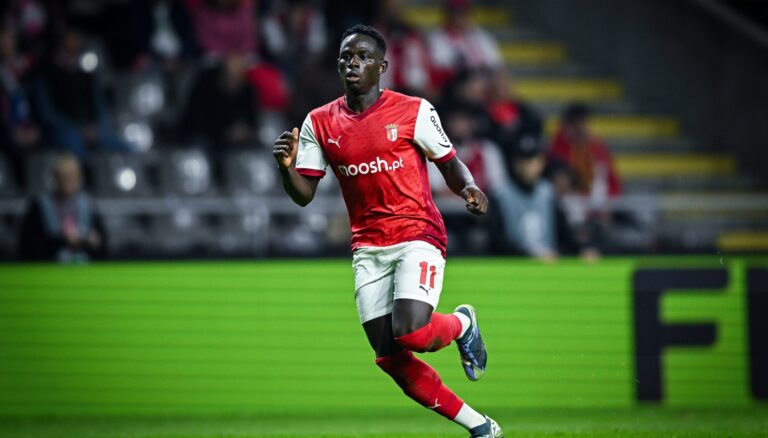
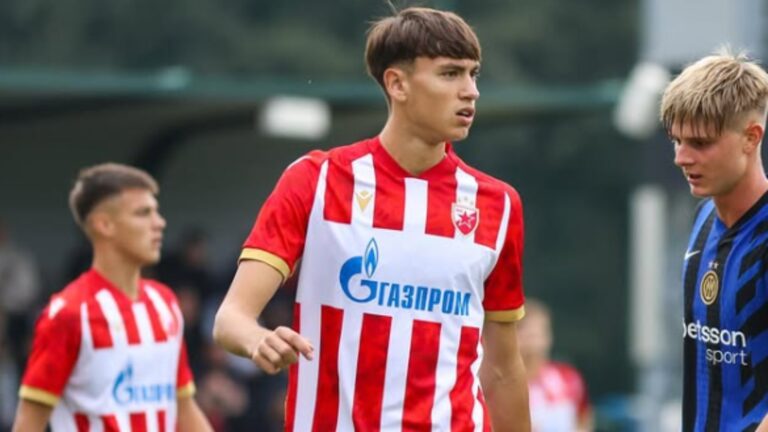
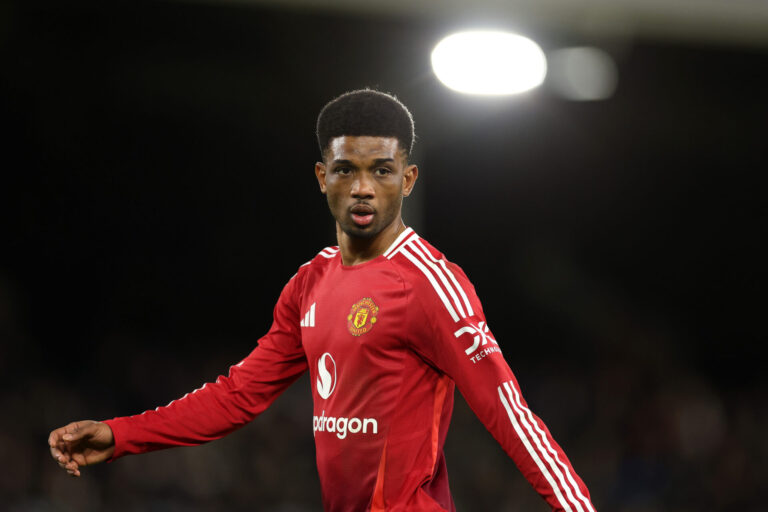
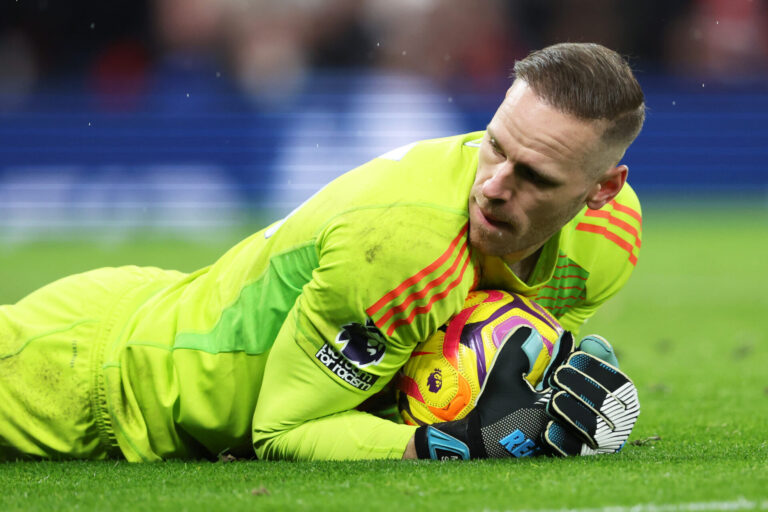
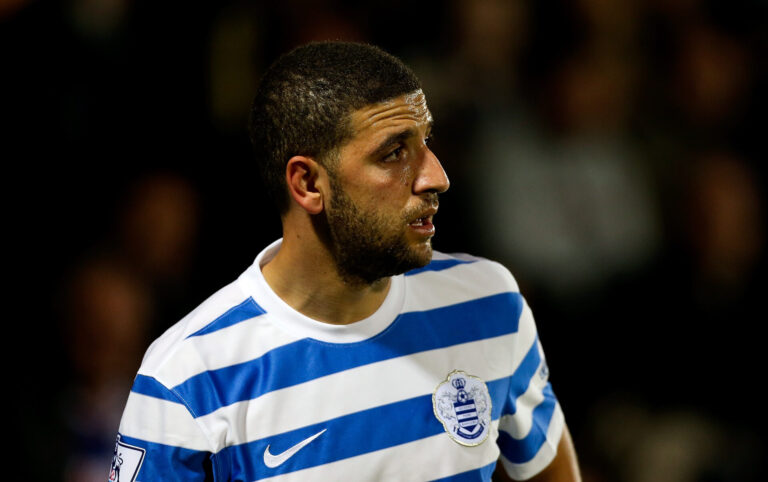
One Comment